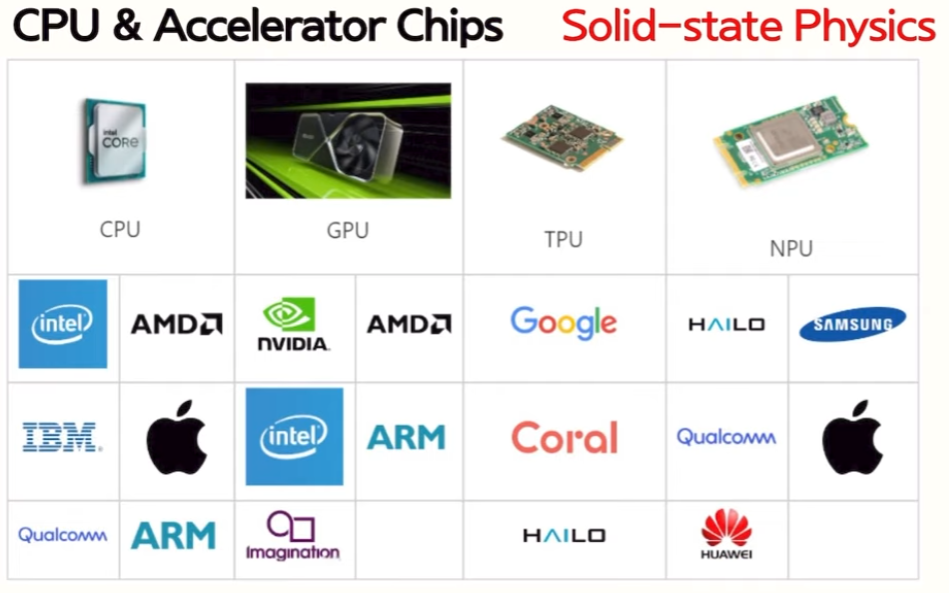
A ONE INSTITUTE
Jul 5, 2025
Today, I’d like to explain why now is the time to take AP Physics C.
Among all science subjects, Physics stands out as one of the most important.
In this post, we’ll explore why students should focus on Physics—and whenever possible, enroll in it without delay.
Why Physics? Because Everything “Hot” Right Now Is Rooted in It.
Let’s begin with the obvious: the most in-demand technologies today all revolve around Physics.

From CPUs (the “brains” of computers), to GPUs (optimized for parallel processing), to accelerator chips that can handle multiple tasks in one go—these are being developed at an accelerated pace.
There are also ASICs, which are chips designed for specific applications, and TPUs, which are optimized for deep learning.

The scientific field most closely involved in developing these kinds of chips?
Solid-State Physics.

Electric vehicles? The principles behind how they operate and even how moving EVs can be wirelessly charged all stem from Electromagnetism.
As chips continue to shrink in size due to technological advancements, the electrons moving within them also get smaller—leading to quantum phenomena like the Tunneling Effect.
This is the basis for Quantum Computing, which has become a major field of innovation.

If quantum computers become commercially viable, they could outperform today’s classical computers by a significant margin.
And what makes quantum computers possible? Quantum Mechanics.
The Physics Behind AI: Neural Scaling Law
Let’s look at AI.
There’s a well-established principle called the Neural Scaling Law.

When large language models train on human language (called tokens), we can chart learning progress by plotting tokens processed on the X-axis and test loss (error rate) on the Y-axis.
What do we see?
As the number of tokens increases, the error rate steadily decreases—until at a certain threshold, the accuracy improves dramatically.
Once it drops, the model’s performance stabilizes.
This jump in accuracy, seen especially in larger models, reveals that bigger models tend to learn faster and better.
This phase transition—when performance suddenly improves—is very similar to the boiling point in physics, and it's precisely what the Neural Scaling Law captures.
All of this is grounded in Statistical Physics.
Yes, even today’s most advanced AI learning systems can be explained through theoretical principles in Physics.
The Physics of Energy Efficiency

Take a look at Landauer’s Bound, which tells us the minimum amount of energy required to erase a single bit of information.
It’s not insignificant. Erasing just one bit requires energy calculated as kT ln2.
With the rise of AI and data centers entering every aspect of our lives—and the eventual arrival of humanoid robots into homes—energy efficiency and heat dissipation become massive engineering challenges.
How do we solve them?
Again, through Thermodynamics—another core branch of Physics.
So, whether it’s developing next-gen chips, running AI, operating electric vehicles, or managing energy and heat—Physics has the answers.
Key Fields:
Solid-State Physics
Electromagnetism
Quantum Mechanics
Statistical Physics
Thermodynamics
It’s no exaggeration to say: Nearly everything “hot” today is tied to Physics.
Why AP Physics C? And Why Now?

The AP exams are administered by the College Board, which frequently updates the test structure.
Why? Because the College Board regularly surveys universities to ensure that AP courses reflect the level and curriculum of college-level freshmen science courses.
Based on university feedback, the AP Physics C exam has undergone major structural changes.
It is now divided into:
Mechanics
Electricity & Magnetism (E&M)
Recently, 5 multiple choice questions were added, along with 1 new free-response question.
The total exam time has doubled from 90 minutes to 180 minutes.
Now:
40 Multiple Choice Questions in 80 minutes
4 Free Response Questions in 100 minutes
This format brings Physics C into full alignment with AP Physics 1 and 2.
Previously, Physics C was seen as a “half-length” exam. No longer.
Today, Physics C is just as robust, and arguably more advanced—especially because it includes Calculus, unlike Physics 1 or 2.
Among AP science subjects:
Core subjects: Biology, Chemistry, Physics 1, 2, and C
Elective: Environmental Science
Given the changes in exam structure and the focus on Physics C, the message is clear:
When selecting science courses, you must prioritize Physics.
What Do Top Universities Say?



Let’s look at a few examples:
Caltech (which openly states “Caltech is hard”) lists Math first, followed by Physics, as the two most foundational subjects for STEM students. They even allow exceptions if scheduling conflicts arise—but only with proper documentation.
Carnegie Mellon expects incoming students to have completed Calculus, and in its science recommendations, it places Physics at the top.
UC Berkeley, consistently ranked among the top 5 for Engineering, explicitly states that students should take lab-based science, and singles out Physics as a priority.
The conclusion?
Everything at the cutting edge of science and technology today—chips, robotics, energy systems, AI—is directly tied to Physics.
And the College Board's changes to the AP Physics C exam, effectively doubling its weight, further support this reality.
Final Recommendation
If you want to showcase your scientific potential—take Physics.
If you want to shine even brighter—take AP Physics C.
This is where students stand out. This is how you demonstrate serious STEM readiness.
Take the challenge. Prepare smart.
Use www.ett-test.com for high-quality AP Physics C practice, and take your learning to the next level.
Today, we’ve explored why AP Physics C is no longer optional—but essential.
For questions or support, feel free to reach out to A ONE INSTITUTE.
Thank you.

